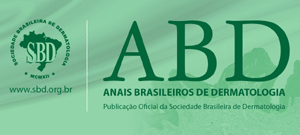Resumo em Inglês:
Abstract: Background: Metals are common agents of allergic contact dermatitis, occupational or not, with decreasing incidence over the last years in some countries that have regulated the amount of nickel in objects. Objectives: To analyze and compare with previous studies the profile of metal sensitization between 2003-2015. Methods: Patients who underwent patch testing between 2003-2015 were evaluated retrospectively regarding the sensitization rates to metals, the associations between them, the relationship with profession and epidemiology. Results: Of the 1,386 patients tested, 438 (32%) had positive test to some metal, similar results to the 404/1,208 (33%) of the previous study (1995-2002) performed at the same service (p=0.32). The frequency of nickel (77%), cobalt (32%) and chromium (29%) changed slightly (p=0.20). Most cases of sensitization to chromium were related to the occupation (64%), in contrast to nickel and cobalt (p<0.0001). There was a predominance of females among those sensitized to metal in both studies (p=0.63) and the age group of 20-49 years old (p=0.11); the number of fair-skinned individuals increased (p<0.001), as well as the lesions in the cephalic segment (50.5%; p<0.0001) and hands (45%; p<0.0001), which are not the most frequent location anymore. The number of cleaners decreased (39% vs. 59%; p<0.0001), which still lead in front of bricklayers/painters, which increased (14% vs. 9%; p=0.013). The frequency of wet work reduced (65% vs. 81%; p<0.0001). Study limitations: The study included a single population group; only patients with positive tests to metals were considered - the others were not evaluated for the possibility of false negatives. Conclusion: The sensitization to metals, occupational or not, has been significant over the last 21 years, with few epidemiological changes.
